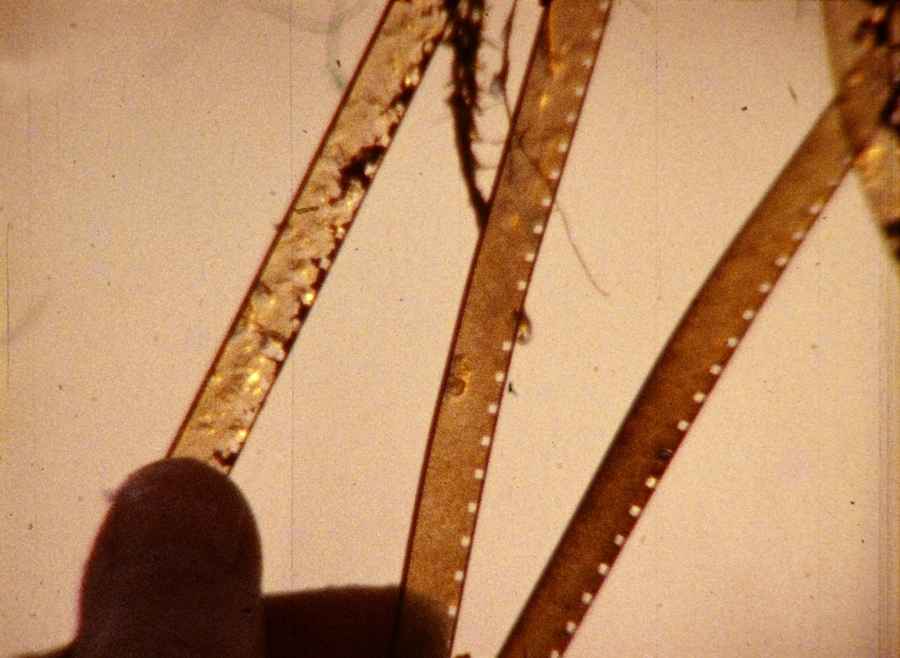

Schmelzdahin
Schmelzdahin fue un colectivo de cine fundado en Bonn, Alemania Occidental, en 1979, integrado por Jochen Lempert, Jochen Müller y Jürgen Reble. Como grupo, exploraron de manera conjunta la grabación, el montaje y el tratamiento del material fílmico, trabajando principalmente con metraje encontrado que a veces reeditaban. Interesados en la llamada “verdad química”, la idea de que el proceso de revelado nunca se detiene realmente, experimentaron con la película expuesta de múltiples formas, investigando cómo la descomposición bacteriológica, la degradación y los procesos químicos afectan al material. Entre 1979 y 1989 realizaron cerca de veinte cortometrajes bajo el nombre de Schmelzdahin, sin identificar a los autores individualmente.
Stadt in Flammen (1984) / 5’ 20’’ / super 8
Stadt in Flammen nace de como un experimento sobre los efectos microbiológicos en la película. Para ello enterraron una película de serie B, enfrentando el medio a diversos tipos de bacterias, para posteriormente sobrecalentar la película. Los resultados se copiaron en una nueva película que preserva la película en su estado de transformación, sin reconstruir la narrativa original.
Aus den Algen (1986) / 8’ 30’’ / super 8
En Aus den Algen, durante el invierno de 1985, arrojaron un rollo de Ali Baba y los cuarenta ladrones a un estanque, recuperándolo un año después. El metraje, parcialmente degradado y colonizado por algas, generó patrones abstractos que se convirtieron en el contenido de la nueva película, combinando material descompuesto y partes intactas.
15 Tage Fieber (1989) / 14’ / super 8
Antes de que el grupo se separara, en 1989 produjeron 15 Tage Fieber. Mientras trabajaban en un proceso químico específico de coloración, empezaron a tener fiebre. Sorprendidos por los maravillosos resultados que obtuvieron en forma de solarizaciones coloreadas, decidieron continuar con el proceso durante 15 días, tras los cuales «la fiebre remitió». La banda sonora incluye varias piezas grabadas por los músicos Bruce Gilbert y Graham Lewis.

Schmelzdahin is a film group from Bonn, West Germany, founded in 1979. Composed of Jochen Lempert, Jochen Müller and Jürgen Reble, Schmelzdahin jointly carried out research in the fields of shooting, montage and material processing. The collective worked mostly with found footage, third-party film material that they sometimes re-edited. True to the “chemical truth” that the development process never really ends, the filmmakers experimented with the exposed material in a variety of ways. As a part of this, lengthy studies relating to the effects that bacteriological decomposition, disintegration, and chemical processes have upon the film were carried out. Within a period of ten years, some twenty short films were made and published world-wide carrying the Schmelzdahin name, without any personal reference being made to the artists behind.
Stadt in Flammen (1984) / 5’ 20’’ / super 8
Stadt in Flammen is the result of a study on microbiological effects on film. A B-movie was treated with bacteria by burying it in the garden and then overheated. The results of these natural processes of decay or aging are then copied back onto film and thus conserved in the state of their dissolution, no longer showing a figurative represented scene.
Aus den Algen (1986) / 8’ 30’’ / super 8
During the winter of 1985, they threw a reel of Ali Baba and the Forty Thieves into a small pond, retrieving it a year later. This experience is described in Aus den Algen. In the first minutes it shows how they recovered the film material. Only the original medium survived and seaweed cultures settled on it producing abstract patterns, which now provide the content of the images. It was later edited into a new film combining parts of the decomposed strip with unaltered footage.
Aus den Algen (1986) / 8’ 30’’ / super 8
Before the group split up, in 1989 they produced 15 Tage Fieber. While working on a specific chemical coloring process they began to get feverish. Surprised by the wonderful results they obtained in the form of colored solarizations, they decided to continue with the process for 15 days, after which “the fever subsided”. The soundtrack includes various pieces recorded by musicians Bruce Gilbert and Graham Lewis.